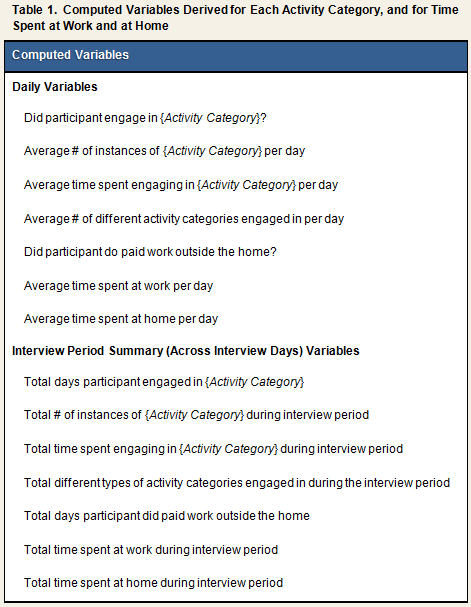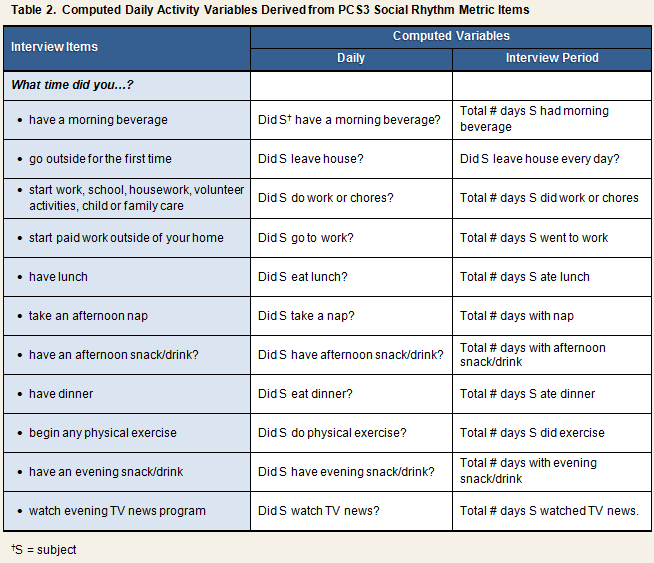Daily Activities (PCS3)
As part of the evening interview component included in PCS3, participants reported on the types of activities they engaged in throughout the day, how much time they spent involved in each activity, and whether they engaged in that activity alone or with other persons (see Daily Social Interactions).
| ANALYSIS NOTE: | |
|
Whereas the evening interviews conducted in PCS3 instructed participants to report on all activities they engaged in during the preceding 24 hours, interviews conducted in PMBC asked participants to describe only those activities in which they engaged with one or more other persons. Accordingly, whereas data collected from PCS3 interviews can be used to derive a comprehensive assessment of participants’ total (i.e., social and solitary) daily activities, PMBC interview data can be used only to approximate participants’ total social activities. Because of this inherent nonequivalence of the two sets of data, total daily activity variables are available for PCS3 only. |
On each evening during the interview period, participants were asked specifically about their engagement in 5 general categories of activity during the past 24 hours:
- Meal, drink, snack, coffee, etc.;
- Leisure activities at home;
- Leisure activities away from home;
- Work around the house; and
- Family or personal errands away from home.
In the event that a participant engaged in an activity that could not be classified as belonging to one of the above 5 categories, the option was available for the interviewer to add up to 2 supplementary activity categories (see also PCS3 Interview Form).
In addition to activity-specific items, participants were asked to generate an overall estimate of how much time they spent during the past 24 hours doing paid work outside of the home as well as how much time they spent at home (excluding any time when they were sleeping).
Variables
For each of the 5 categories of activity, a set of daily variables and a set of interview period summary variables were created. To avoid the redundancy of repeating the same sets of variables for all 5 activity types, Table 1 displays both daily and interview period summary variables for a non-specified activity category. Also included in Table 1 are daily and summary variables computed for the specific “time at work” and “time at home” items.

In contrast to the activity variables described on the Daily Interviews, Daily Social Interactions page, the variables described here are computed across all instances of a given activity, irrespective of whether the participant engaged in that activity with another person. Thus, the PCS3 data can be used to create variables representing the proportion of participants’ daily activities that were social and the proportion that were solitary. Because solitary activities were not assessed in PCS2 and PMBC studies, proportion cannot be calculated from those data. Examples of variables of this kind that are contained in the Common Cold Project data set include the following:
- % total activities that were social;
- % meals that were social;
- total days solitary activities outnumbered social activities.
Items from the Daily Social Rhythms portion of the evening interview (see PCS3 Interview Form, pp. 3-4) also were used to compute variables representing participants’ daily activities. Relevant items and computed variables are displayed in Table 2.
| ANALYSIS NOTE: |
|
Because the social rhythm metric was administered in parallel with the daily activities component of the interview rather than as a supplement to it, several of the items contain redundant information. Thus, activity totals derived from social rhythm data are computed separately from totals derived from other parts of the interview. |

As with the created activity variables described above, variables derived from social rhythm metric items include both social and solitary activities in their computation. Thus, proportions of activities that were social/solitary have been computed from these variables as well and are available in the Common Cold Project data set.